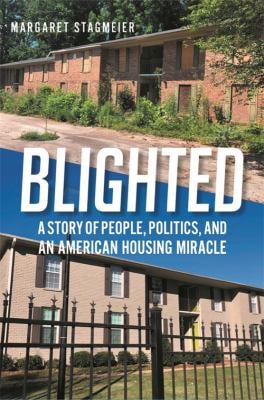 Recently, I talked with Margaret (Marjy) Stagmeier, about her book: Blighted (2022) and efforts to transform a low-income apartment community in the Cleveland Avenue neighborhood of south Atlanta, GA. She is labeled as a Compassionate Capitalist by some in the media and a self-described champion of an affordable-housing education model. As part of her journey in the asset management and investment world, she passionately shared how the book by Matthew Desmond, Evicted: Poverty and Profit in the American City (2016) significantly influenced her work to tackle Atlanta’s affordable housing crisis.
Recently, I talked with Margaret (Marjy) Stagmeier, about her book: Blighted (2022) and efforts to transform a low-income apartment community in the Cleveland Avenue neighborhood of south Atlanta, GA. She is labeled as a Compassionate Capitalist by some in the media and a self-described champion of an affordable-housing education model. As part of her journey in the asset management and investment world, she passionately shared how the book by Matthew Desmond, Evicted: Poverty and Profit in the American City (2016) significantly influenced her work to tackle Atlanta’s affordable housing crisis.
Blighted: a story of people, politics and an American housing miracle is a must-read book for anyone interested in the issues of urban blight, housing, and the role of private-public partnerships in transforming communities. As a managing partner at TriStar, a global commercial real estate investment and development company and founder of Star-C, a non-profit organization whose mission is to reduce resident transiency in affordable housing communities near low-performing schools, Marjy and her team transformed the blighted and aging Summerdale Apartments.
As part of the transformation, Star-C invested in community-based programs that provide supportive services through after-school study sessions, free summer camps, health clinics, gardens for fresh food and mentors for children in Summerdale Apartments. The programs, coupled with affordable housing, helped create a strong sense of community, improving the quality of life for children and residents.
The book is a fascinating account of transformation for a low-income apartment community redeveloped from chaos and crisis into a thriving community and how positive social change was made possible for the families in one of the city’s grittiest neighborhoods. The success of the Summerdale project is attributed to the resources from multiple partners and a holistic community development approach.
One of the most significant implications of this book for school system leaders is the interconnectedness between housing, neighborhoods, and schools. As evidenced in the book, affordable and stable housing is essential to children’s opportunities for educational success. When families are forced to move frequently due to rising rents or eviction, children’s education is disrupted. Moreover, children living in unstable housing may experience stress and trauma, which can negatively impact academic performance and mental health.
Marjy narrates aspects of her collaborative partnership with Dr. Anyee’ Payne, the former principal of Cleveland Avenue Elementary School (CAES) who she described as “the heroic principal.” I have visited CAES previously and can attest to Dr. Payne’s stellar leadership as an instructional leader, developer of human capital, and community collaborator. She and her team (with the support of community partners) did a remarkable job of improving educational outcomes while attending to the social and emotional well-being of their students.
In conclusion, Blighted is an inspiring book that shows how private-public partnerships can transform impoverished neighborhoods into thriving communities. It also highlights the critical connection between affordable and stable housing, neighborhood characteristics, and children’s educational succcess. School systems across the country can learn from the Summerdale project to work with non-profit organizations and other partners to provide stable and affordable housing for families in their respective communities. By doing so, they can create a brighter furture for the children they serve.
